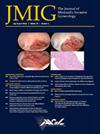Perioperative Antibiotic Choice and Postoperative Infectious Complications in Pelvic Organ Prolapse Surgery
IF 3.5
2区 医学
Q1 OBSTETRICS & GYNECOLOGY
引用次数: 0
Abstract
Objective
The objective of this study was to determine how rates of postoperative infectious complications after pelvic organ prolapse surgery differ based on perioperative antibiotic administered. In particular, we sought to determine whether anaerobic coverage is associated with reduced rates of infectious complications.
Design
This was a retrospective cohort study.
Setting
Premier Healthcare U.S. national database, a comprehensive all-payer dataset capturing patients from urban and rural nonprofit, community, and teaching hospitals.
Participants
Adult patients who underwent vaginal, laparoscopic, and/or abdominal prolapse surgery with or without hysterectomy from January 2000 to March 2020. Procedures with and without mesh were included.
Interventions
Rates of infectious complications were compared among patients who received guideline-concordant antibiotic regimens, including those with anaerobic coverage. The primary outcome was any surgical site infection within 30 days of surgery without mesh or 90 days of surgery involving mesh.
Results
Among 130,198 prolapse surgeries, the most common antibiotic regimens were cefazolin (n = 97,058, 74.5%), second-generation cephalosporin (n = 16,442, 12.6%), clindamycin + aminoglycoside (n = 8,397, 6.4%) and cefazolin + metronidazole (n = 4,328, 3.3%). On multivariable logistic regression, only clindamycin + aminoglycoside was associated with a higher rate of surgical site infections (OR = 1.37; 95% CI 1.09–1.72) and other infectious morbidity (OR = 1.26; 95% CI 1.12–1.42) when compared to cefazolin alone. The addition of metronidazole to cefazolin was not associated with reduced rates of surgical site infections (OR = 1.09; 95% CI 0.82–1.45). Obesity (OR = 1.22; 95% CI 1.03–1.43), diabetes without complication (OR = 1.30; 95% CI 1.08–1.57), Charlson comorbidity score >0 (OR = 1.24; 95% CI 1.06–1.45), and tobacco use (OR = 1.22, 95% CI 1.05–1.40) were also associated with increased composite surgical site infection.
Conclusion
Compared with cefazolin alone, the use of alternative perioperative antibiotics, including those with anaerobic coverage, was not associated with reduced infectious complications after pelvic organ prolapse surgery in this U.S. national sample.
盆腔器官脱垂手术的围手术期抗生素选择与术后感染并发症。
研究目的本研究旨在确定盆腔器官脱垂手术后感染性并发症的发生率因围手术期使用的抗生素而有所不同。特别是,我们试图确定厌氧菌覆盖是否与感染性并发症发生率的降低有关:设计:这是一项回顾性队列研究:Premier Healthcare 美国国家数据库是一个全面的全付费者数据集,收集了来自城市和农村非营利性医院、社区医院和教学医院的患者:2000 年 1 月至 2020 年 3 月期间接受过阴道、腹腔镜和/或腹部脱垂手术并进行或未进行子宫切除术的成年患者。干预措施:干预措施:比较了接受与指南一致的抗生素治疗方案(包括厌氧菌覆盖方案)的患者的感染性并发症发生率。主要结果为无网片手术后 30 天内或有网片手术后 90 天内的任何手术部位感染:在130,198例脱垂手术中,最常见的抗生素方案是头孢唑林(97,058例,74.5%)、第二代头孢菌素(16,442例,12.6%)、克林霉素+氨基糖苷(8,397例,6.4%)和头孢唑林+甲硝唑(4,328例,3.3%)。在多变量逻辑回归中,与单用头孢唑啉相比,只有克林霉素+氨基糖苷与较高的手术部位感染率(OR 1.37;95% CI 1.09-1.72)和其他感染性发病率(OR 1.26;95% CI 1.12-1.42)相关。在头孢唑啉中添加甲硝唑与手术部位感染率降低无关(OR 1.09;95% CI 0.82 - 1.45)。肥胖(OR=1.22;95% CI 1.03-1.43)、无并发症的糖尿病(OR=1.30;95% CI 1.08-1.57)、Charlson合并症评分大于0(OR=1.24;95% CI 1.06-1.45)和吸烟(OR=1.22,95% CI 1.05-1.40)也与复合手术部位感染增加有关:结论:在这一美国全国样本中,与单纯使用头孢唑啉相比,围手术期使用其他抗生素(包括厌氧菌覆盖的抗生素)与盆腔器官脱垂手术后感染并发症的减少无关。
本文章由计算机程序翻译,如有差异,请以英文原文为准。
求助全文
约1分钟内获得全文
求助全文
来源期刊
CiteScore
5.00
自引率
7.30%
发文量
272
审稿时长
37 days
期刊介绍:
The Journal of Minimally Invasive Gynecology, formerly titled The Journal of the American Association of Gynecologic Laparoscopists, is an international clinical forum for the exchange and dissemination of ideas, findings and techniques relevant to gynecologic endoscopy and other minimally invasive procedures. The Journal, which presents research, clinical opinions and case reports from the brightest minds in gynecologic surgery, is an authoritative source informing practicing physicians of the latest, cutting-edge developments occurring in this emerging field.

 求助内容:
求助内容: 应助结果提醒方式:
应助结果提醒方式:


